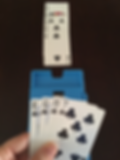Spade Article - Counting Winners Part 3
The final part of counting winners revolves around understanding the power of length. No matter what the contract is, our long suits provide an excellent source of tricks. Why? Because when the opponents run out of a suit, our little cards become high cards. If I am the only person with diamonds, whatever diamonds I have will be winners, even if they are the 5, 4, and 3.
Consider the following suit:

If we were to count winners in this suit, we would count only three: the A, the K and the Q. But how many tricks are we actually going to take?
When you play the A, each defender (and your other hand) will have to follow suit.

When you play your K, again, each has to follow suit.

Play your Q and the last defender with a diamond must play it...

Now, the defenders are now completely out of the suit, which means if you lead your 4 and your 2, they will each win a trick!

We wouldn’t normally expect to win a trick with the 2 of diamonds, but that’s the power of a long suit. The little cards become good after the opponents run out!
How will we know if the opponents will run out? By considering the split. Let’s break this down into steps:
Step 1: Add together how many of the suit you have.

In this case, we have nine hearts.
Step 2: Determine how many the opponents have.
This is simple subtraction. We know there are thirteen hearts in the deck. Therefore if we have nine, the opponents have four. 13 – 9 = 4.
Step 3: Consider the distribution
Often times when we are making decisions about how to play a suit, we need to consider the split (or distribution) of the suit. In the case where the opponents have four cards, there are three possible splits: 4-0 (one opponent having all four and the other having none), 3-1 (one opponent having three, the other having one), and 2-2 (each opponent having two of the suit).
Step 4: Compare the worst possible distribution to your cards and determine the number of winners.
In this case, even if one defender has all four hearts, after we play the A, K, Q, and J, they will be out. Since we can guarantee that the opponents will be out after we play the top four hearts, we can actually count six winners in this suit, because our 3 and 2 will be good (the opponents won’t have anything left and therefore won’t be able to beat the 3 and 2.)
Let’s look at another hand.

Go through the steps with me (scroll down for answers):
Step 1: How many do we have?
Step 2: How many do the opponents have?
Step 3: What are the possible splits? (Hint, there are two)
Step 4: Compare the worst possible distribution to your cards and determine the number of winners.
Step 1: We have ten.
Step 2: They have three. 13 – 10 = 3.
Step 3: 3-0 (one opponent has all three, the other has none) and 2-1 (one opponent has two, the other has none).
Step 4: The worst-case scenario means that after we play our A and our K, the opponents will still have a spade left. In this case, we can only count two winners because if the split is 3-0, whatever the opponent has left after we play the A and K will win and stop our suit.
For the purposes of counting winners, we only count the entire suit as winners if the worst possible split still results in the opponents being out by the time we get to our lower cards. We do this for the same reason we only count sure winners when counting other suits, so that developing the suit is a part of our plan. If we need the suit to split a certain way in order for us to get additional winners, then testing how it splits (by playing a high card or two) needs to be a part of our plan. Remember, a winner isn’t a winner if something needs to happen in order for it to win. We only count our long suit tricks as winners if they can win if the suit splits in the worst possible way.
When we start making choices about which suits to develop to generate the additional winners we need, we take these steps further and think about the different consequences of each split and when we will know what we need to know about the suit.
For the following suits, go through the four steps:
1.

2.

3.

4.

5.

1. We have nine. The opponents have four. The suit could split 4-0, 3-1, or 2-2. We have five winners because even if the suit splits 4-0, we have the top four cards in the suit. After we play the A, K, Q, and J, the opponents will be out, making our 2 good. Don’t forget we can only take as many tricks as the number of cards on our longest suit, in this case five.
2. We have nine. The opponents have four. The suit could split 4-0, 3-1, or 2-2. We have only three winners because if the suit splits 4-0, the opponents will be able to take the fourth trick with their J or T.
3. We have ten. The opponents have three. The suit could split 3-0 or 2-1. We have seven winners because even if the split is 3-0, our A, K, and Q will take all of the opponents’ cards and the remainder will be good. We can play the suit seven times because we have seven on our longest side.
4. We have eight. The opponents have five. The possible splits are 5-0, 4-1, and 3-2. We have five winners, because even if the suit splits 5-0, we have the top five. (Alternatively, we could have counted five based on the fact that we had the top five spades and the length of our longest side was five. It's always nice to be able to get to the same place different ways!)
5. We have seven, the opponents have six. The possible splits are 6-0, 5-1, 4-2, and 3-3. We only have five winners because we only have the top five cards in the suit. If the suit splits 6-0, our 8 will not be good.
This concludes the series on counting winners. Hopefully, you now have a very good sense of how to do this invaluable technique. At the beginning of each no trump hand you play, you should count your winners, compare what you have to what you need, and come up with a plan to create the winners you need.






















